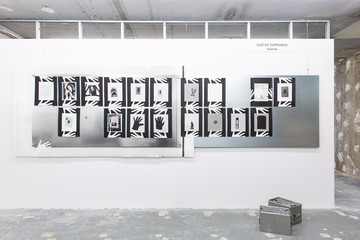For Paris Internationale, the gallery’s presentation suggests a dialogue between the sculptural work of Irina Lotarevich and photographic oeuvre of Sophie Thun.
Lotarevich’s practice is shaped by the intersection of her own subjective experience with larger systems. The minimal yet complex and specific forms of her sculptures reference architecture, bureaucracy, labour, and parts of her body. The wall sculpture is made of a drawer-like aluminum form filled with locks and keys dangling from the sides). The sheer quantity and repetition of locks, divided into neat rectilinear compartments, evokes an obsessive mindset, while the drawer-like form also doubles as a plan of an apartment or city. The keys can be turned, but the locks don’t actually open anything; we face an exterior barricaded by locks that don’t offer access (to any interior). As the title ‘Housing Anxiety’ suggests, the work could also refer to the precarity of navigating constantly shifting and unstable housing situations.
The floor-based metal works presented here are based upon functional storage boxes. The aluminium surfaces of these handmade objects are imprinted with an enlarged cast of the artist’s skin. With these works, Lotarevich explores ideas of compartmentalisation and the notion of the box becoming a parallel for the self, in its capacity as a vessel or container. With the skin’s imprint, the walls of box come to represent borders between an outer, social world and the inner, psychic life. The latter, containing thoughts, memories, desires and traumas, is gathered into archival bodies that may be moved, stored or unpacked.
Thun works primarily with techniques of analogue photography, referring the spaces and processes that define its production and exhibition. The dialectical interrelations between the scene of production and the work’s presentation, between the setting of the artist’s labour and the physical presence of the body, are recurrent themes in Thun’s practice. Her hands, which hold the negatives while exposing them, consistently form the frames to her photographs. Their white imprints – photograms – are both markers of her authorship and indices of the mechanical process of print production. Moreover, the artist poses for herself in most of the photographs. Her own body is always immediately available to her as a material for artistic production.
In the ongoing series ‘After Hours’, Sophie Thun photographs herself in various rooms, which she occupies while undertaking production work for colleagues. In doing so, she draws attention to a seldom-mentioned fact; namely, that many established artists have their work produced by various assistants or specialists, either in part or entirely. These workers are often artists themselves who are dependent upon additional jobs to support their own artistic practices. Dependency relations like these consolidate hierarchical structures, not least because they ultimately determine who can afford to dedicate more time to their own artistic work. The large panel presented here shows some of the photograms of all her personal belongings that were smaller than an 8 x 10 ” negative. Their arrangement is a form of self-representation, as the selection of the depicted objects can be read as a story about somebody – about the artist.
These distinct groups of work by Lotarevich and Thun reflect a shared interest in archives: while Lotarevich’s pieces refer to containers for archiving, Thun creates her own archive. Both artists share an interest in the confines of action in one’s work: Having grown up in socialist-oriented Poland, Thun knows the stories of the Polish avant-garde from the 1960s on. Many of these artists understood how to act within set limits, to make use of given means and to create space for their own artistic practice with a kind of reflected pragmatism. Lotarevich’s visual vocabulary draws from functional designs such as submarine or office furniture, which must be resourceful, modular and space-efficient, representing values that Lotarevich applies in her own artistic practice. The presence of the artists’s hands becomes apparent time and again, highlighting their primacy in the works and subsequently impressing themselves upon their surfaces.. As Thun inscribes herself through the photographs of her own body, Lotarevich casts part of her own skin. Both gestures make tangible reference to their position as artists.

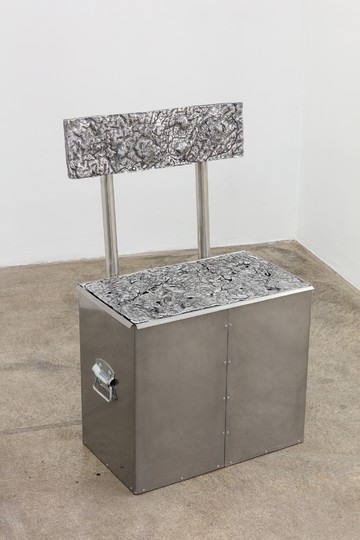
cast and polished aluminium, stainless steel, hardware
87 x 52 x 35,5 cm
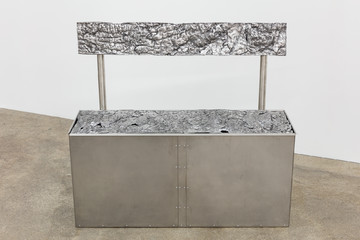
cast and polished aluminium, stainless steel, hardware
87 x 97 x 35,5 cm
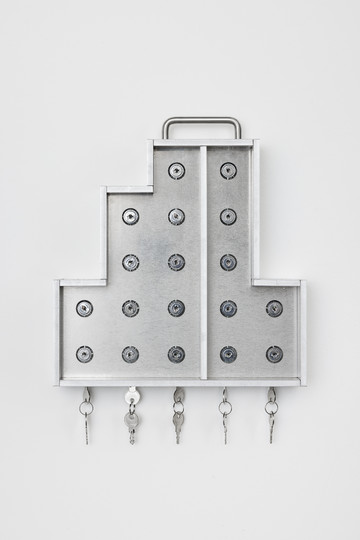
aluminium, stainless steel, locks and keys
39 x 37 x 7 cm
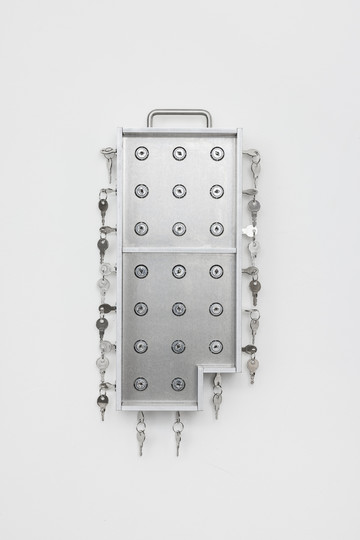
Aluminum, stainless steel screws, locks and keys
50 x 26 x 7 cm
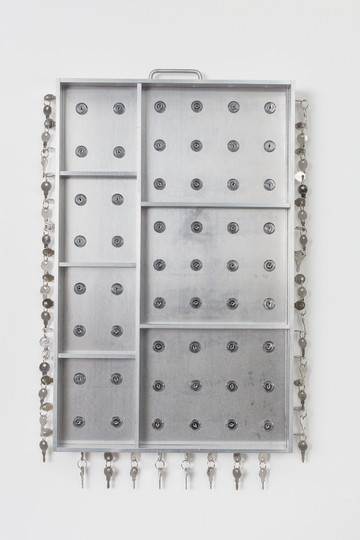
Aluminum, stainless steel, locks and keys
47 x 30 x 7 cm
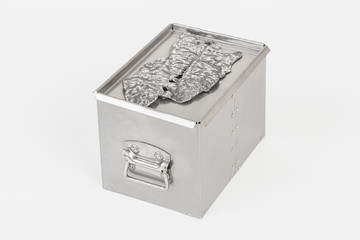
cast and polished aluminium, stainless steel, hardware
23 x 24,5 x 33 cm
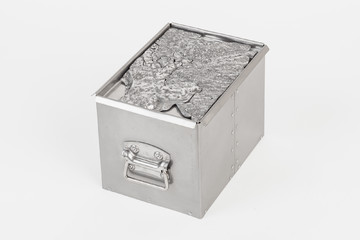
cast and polished aluminium, stainless steel, hardware
23 x 24,5 x 33 cm
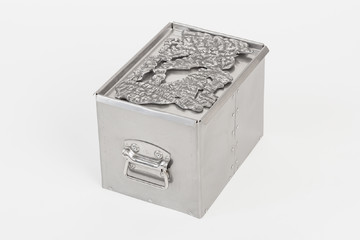
cast and polished aluminium, stainless steel, hardware
23 x 24,5 x 33 cm
Irina Lotarevich’s sculptural practice is shaped by the intersection of her own subjective experience with larger systems. Materially, she works with wood, metal, and casting techniques, frequently combining both high and low or de-valued materials with sophisticated fabrication techniques and a sensitivity to building spatial narratives. Lotarevich also interweaves her own writing and use of language into her work. The minimal yet complex and specific forms of her sculptures reference architecture, bureaucracy, labor, and parts of her body.
Irina Lotarevich (*1991, lives and works in New York City and Vienna) studied at Cornell University, Hunter College, and the Academy of Fine Arts Vienna.
She has a forthcoming solo exhibition at SOPHIE TAPPEINER and will also be included in two group exhibitions at Scherben Scherben in Berlin (DE), and AND NOW, Dallas (US).
Recent solo and duo exhibitions include: 2020 ‘Refinery‘, SOPHIE TAPPEINER, Vienna (AT); 2019 ‘Galvanic Couple’, FUTURA Centre for Contemporary Art, Prague (CZ), ‘Pensive State‘ a two-person show with Anna Schachinger, SOPHIE TAPPEINER, Vienna (AT); 2017 ‘Schemas‘, Kevin Space, Vienna (AT).
Her works have recently been included in the following group exhibitions: ‘Systems of Belief’, HALLE FÜR KUNST, Graz (AT), ‘Cafe Heaven‘, Salzburger Kunstverein, Salzburg (AT), ‘Don’t Say I Didn’t Say So‘, Kunstverein Bielefeld, Bielefeld (DE), MAK Biennale for Change, Museum of Applied Arts, Vienna (AT), ‘Ebbing Touch’, Galeria Madragoa, Lisbon (PT), ‘Metal Machine Music’, Louis Reed, New York City (US), ‘The Constant Condition’, Ghouliana, New York City (US), ‘Opening’, Loggia, Vienna (AT), among others.
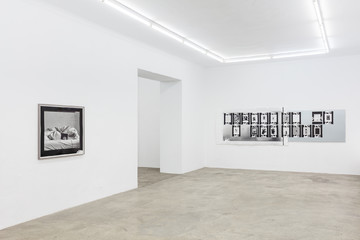

silver gelatine print and photographs on baryta paper, steel plates mounted on plywood, magnets
127,5 x 425 x 10 cm
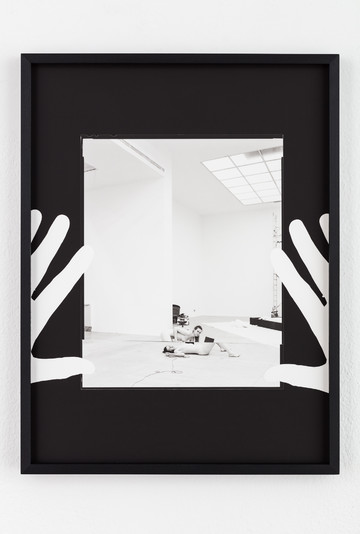
photogram on baryta paper in artist’s frame
40 x 30 cm
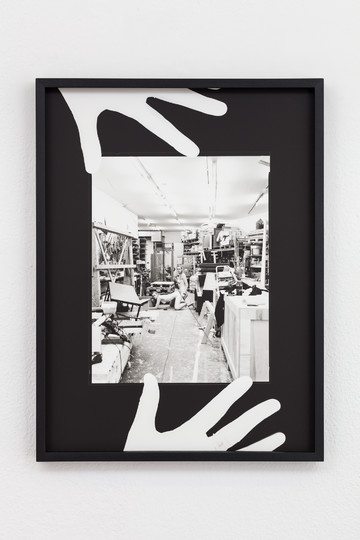
photogram on baryta paper in artist’s frame
40 x 30 cm
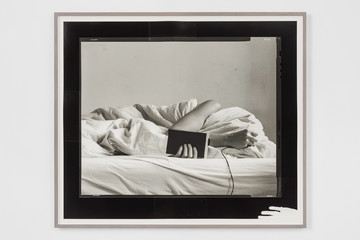
silver gelatine print and photogram on baryta paper in artist’s frame
94,7 x 110,5 cm
Sophie Thun (*1985) works primarily with techniques of analogue photography, its spaces, processes as well as conditions of production and exhibition.
Raised in Warsaw, Thun completed her master’s degree at the Academies of Fine Art in Vienna (2017, Martin Guttmann and Daniel Richter) and Cracow (2010).
Her upcoming projects include a solo exhibition at Madragoa in Lisbon (PT) and the group exhibition 'Seen-Unseen' at Plenčnik House in Ljubljana (SI).
Recent solo and two person exhibitions include: 2022 'Trails and Tributes', Kunstverein Hildesheim, Hildesheim (DE), ‘Merge Layers‘, SOPHIE TAPPEINER, Vienna; 2021 ‘SHIFTS (RAL5014)‘, Rosa Stern Space, Munich, ‘Förderstipendium’ with Sara Cwynar as part of the DZ Bank Work Grant, Art Foyer, Frankfurt, ‘I don’t Remember a Thing. Entering the Elusive Estate of ZDZ*‘ Sophie Thun and the archive of Zenta Dzividzinksa, Kim? Contemporary Art Center, Riga; 2020 ‘Stolberggasse‘, Secession, Vienna, ‘Room Tour‘ with Karolina Jablońska, Galeria Raster, Warsaw, ‘double pose, reflecting self -reflecting pose, double self‘ with Birgit Jürgenssen at Fotograf Festival #10, Uneven Ground, Prague, ‘Extensions‘, C/O Berlin; 2019 ‘Interiors of Photography’, with Mladen Bizumic, Camera Austria, Graz, ‘Extended Double Release’ , Galerie 52, Universität der Künste Folkwang, Essen, ‘After Hours‘, SOPHIE TAPPEINER, Vienna; 2018 ‘Lightbox‘ at Kunstraum, Munich, ‘Les Rencontres d’Arles’, Arles, ‘Double Release‘, SOPHIE TAPPEINER, Vienna.
Selected group shows include: 2022 ‘Something is Burning’, curated by Julius Pristauz, Kunsthalle Bratislava; 2021 ‘Homesick‘, Shivers Only, Paris, ‘Friedl Kubelka vom Gröller: POLYPHONY Songs of Experience’ Museo MACRO, Rome, ‘After the Revolution‘, SOPHIE TAPPEINER, Vienna; 2020 ‘Elisabeth Wild’, curated by Adam Szymczyk, Karma International, Zurich, ‘Monster/Beauty: An Exploration of the Female/Femme Gaze’, curated by Marcelle Joseph, Lychee One, London, ‘Borderlinking’, High Art, Paris, ‘Murderkino’, curated by Brigitte Huck, Galerie Charim, Vienna; 2019 ‘DAGUERRE’S SOUP. Christian Kosmas Mayer x FOTOGRAFIS’ Kunstforum Wien.
Thun was awarded the work grant from DZ Bank for 2019/2020 and the outstanding artist award from the Federal Ministry of Arts and Culture from the Republic of Austria.
Publications: ‘Sophie Thun, First Monographs’, published by Phileas, DISTANZ Verlag, 2022; ‘Sophie Thun’, Secession, Revolver Verlag, 2020; ‘WHITE FLAG’ with Hannah Putz, PAMPAM publishing 2019.
Her work is included in the permanent collections of the Museum der Moderne, Salzburg, of the Landesmuseum Oberösterreich, Linz, Lentos, Linz, of the SMART Museum, Chicago, of the DZ Bank art collection, Frankfurt and of the Verbund Collection, Vienna.

